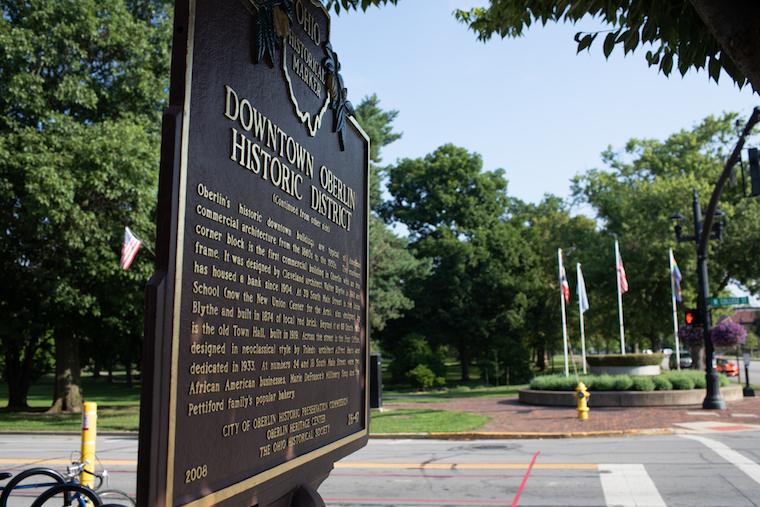App-based Tour Illuminates Oberlin’s History
July 15, 2019
Hillary Hempstead

A historical marker in downtown Oberlin, overlooking Tappan Square.
Photo credit: Tanya Rosen-Jones ’97
What began as an aspiration to open a history museum in Oberlin morphed into a series of app-based tours that aim to represent the city’s diverse history.
Some of the most repeated Oberlin College history tidbits may be these: that it was the first college to admit all students without respect to race, and it was the first to admit women alongside men. But in addition to those defining features, the college and town have a rich history that bears additional explanation.
“Oberlin has an interesting, contested heritage,” says Gary Kornblith, emeritus professor of history. “The town looks very different to those who are connected to the college and very different if you’re part of the town that lives below the poverty line. It’s different if you’re a tenured professor or part of another group.”
Kornblith, along with several other Oberlin citizens including Library Archivist Ken Grossi ; Emerita Professor of History Carol Lasser; Laurel Price Jones ’70; former Oberlin Associate Professor Rhys Price Jones; Liz Shultz, director of the Oberlin Heritage Center , Annessa Wyman, president of the Oberlin African American Genealogy & History Group ; and group member Phyllis Yarber Hogan, endeavored to chronicle various experiences in the city.
So they banded together to create the Coalition for Oberlin History , whose purpose is “to tell Oberlin’s stories in the plural,” says Kornblith.
While the coalition explored the idea of creating a brick and mortar museum to tell the city’s stories, finding a location to house the project proved to be a challenge. But during a sculpture garden tour that used an app to educate users, Kornblith and Lasser stumbled upon the technology they realized could be useful in educating about history—without the expensive overhead of a physical museum.
“We saw great possibilities with using an app—we could easily create multiple tours. I looked into the cost, and the app was free to use. So the price was right,” says Kornblith.
The app’s structure also provided an ideal way for the coalition to easily serve various audiences. Because of Oberlin’s varied history, it was important to the group to highlight a range of Oberlin experiences.
As of now, the group has created four tours that focus on the following: Oberlin schools, Westwood Cemetery, Groveland Street’s African American community, and Oberlin College.
A fifth tour, led by Lasser and a current Oberlin student, covering the history of the town is in the works. Kornblith says the group has discussed producing additional tours in the future.
Produced by Kornblith and Grossi, “Oberlin College: The First Century” takes users on a walk on and around Tappan Square, with eights stops in total. It introduces visitors to the early history of the college, including the founders’ decisions to admit women alongside men and the role of students and faculty in the struggle against slavery in the decades leading up to the Civil War.
The tours are not only a resource for the public. Grossi, who provides instructional sessions for classes including first-year seminars and a history research methods course, also sees a place for them in the classroom.
“It is my intention to either reference or use the tour during instructional sessions or presentations when discussing 19th century Oberlin history,” Grossi says. “The tour would provide another method to share our history with students. I would also encourage students to try all the tours created by members of the Coalition for Oberlin History.”
Each of the Oberlin tours can be accessed for free on the izi.Travel website or by downloading the izi.Travel app from your smartphone’s marketplace.
You may also like…
Josh Nolan Named Vice President, General Counsel, and Secretary at Oberlin
Distinguished attorney brings extensive experience in higher education law.
Learning by Teaching: Oberlin Students Share Global Music with Young Learners
College and Conservatory students in PACE 103 prepare local children for an immersive community concert at Oberlin.
Nuiko Wadden ’02 Joins Oberlin Conservatory Faculty as Assistant Professor of Harp
The versatile musician brings extensive opera, orchestral, and contemporary music experience to her role


